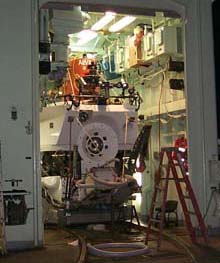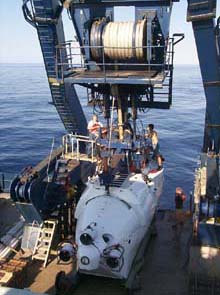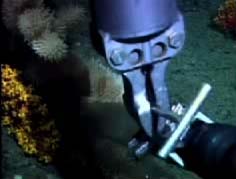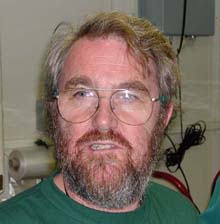
The deep-sea research submersible Alvin in its hangar aboard the R/V Atlantis. Click image for larger view.
Oceanographer Canyon
September 10, 2001
Karl Stanford, Teacher
Lincoln Academy, Newcastle, Maine
Strange and beautiful things were brought to us from time to time, which seemed to give us a glimpse of the edge of some unfamiliar world.
-- Sir Charles Wyville Thompson, The Challenger Expedition, 1876
![]() Watch a video of Alvin sampling invertebrates that live on deep water corals.
Watch a video of Alvin sampling invertebrates that live on deep water corals.
The sky was clear and the seas calm as the crew of R/V Atlantis readied the Alvin manned submersible for the day's dive into Oceanographer Canyon on the edge of the Atlantic continental shelf. Alvin was clearly visible through its open hangar door on Atlantis' fantail. Alvin technicians methodically worked through the 14-pp checklist required for a dive. Like the space shuttle rolling out of its hanger, Alvin began a slow crawl down the rail track leading to the A-frame that would lower it into the calm morning sea. Each crew member and technician carried out his or her task, and soon, scientists Peter Auster and Scott France joined Alvin pilot Phil Forte on the A-frame stairs. The three disappeared into the submersible, and moments later, Alvin's support divers dove into the warm Gulf Stream waters as Alvin slipped silently into the deep blue of Earth's last frontier.

Submersible Alvin being prepared for a descent into Oceanographer Canyon. Click image for larger view.
Oceanographer Canyon lies at the edge of the continental shelf, some 85 nautical mi southeast of Nantucket Island off the coast of Massachusetts. Submarine canyons are of great interest to the marine biologists participating in this leg of the Deep East Expedition. Located at the edge of productive fishing grounds, these canyons may hold the last pristine communities of invertebrates and certain fish. Long-line fishing and trawling have damaged the delicate sea-floor habitats of Georges Bank. In contrast, canyons like Oceanographer have not been impacted by heavy fishing pressure. The habitats of the canyons may act as refuges for some species. In addition, the steep canyon walls provide ecological niches not found in flatter benthic (bottom) environments.
Alvin descended to the canyon floor, to a depth of 1,312 m. The descent through the blackness of the water column was punctuated by sightings of red shrimp, squid, and ctenophores (comb jellies). Once on the bottom, Alvin and its crew completed two video transects. Alvin is equipped with digital video cameras and color-corrected lighting, which yield remarkably crisp images. The video transects of the canyon floor were interrupted to collect suction samples. Alvin technicians fitted the submersible with a fine mesh filter before the first dive. The filter allows Alvin's manipulator to literally vacuum organisms from the corals found on the transects, possibly providing new insights on invertebrates associated with the colonial corals. Dr. Scott France met another dive objective when he collected specimens for studies of genetics and coral reproductive biology. Dr. France will be comparing the DNA of these corals to that of corals collected on dives n other canyons.

![]() Alvin collects a suction sample using one of its robotic arms. Scientists are investigating invertebrates that live on deep water corals, such as this Thourella sp. Click image to see a video of Alvin sampling.
Alvin collects a suction sample using one of its robotic arms. Scientists are investigating invertebrates that live on deep water corals, such as this Thourella sp. Click image to see a video of Alvin sampling.
Because this was Dr. Auster's first dive in Alvin, he was greeted back on deck with buckets of ice water, as is the tradition following one's initial dive!
Interview with Les Watling
Chief Scientist, Leg 1
Darling Marine Research Center
University of Maine
Ocean Explorer: What are your responsibilities as chief scientist on Leg 1 of the Deep East Expedition?
Les Watling: I have various responsibilities, but all are part of mission planning and delegation. This cruise is a little unusual in that we will have a different chief scientist for each of the three legs of Deep East. I act as liaison between the science party and the captain of Atlantis. Since there is a hurricane out there, we may have to make some changes in the dive schedule. The captain explains any changes to me, and I pass them along to the science party. I'm also responsible for the safety and behavior of the science party while on board. Basically speaking, my job is to make sure that the objectives of each principal investigator are met during the cruise. We are fortunate to have this opportunity, and my job is to make sure that we maximize the amount of information we gain from the cruise.
Ocean Explorer: It sounds like you have your hands full. How long has it taken to plan this expedition?

A schematic drawing of the electrophysiology apparatus used to study the color and light sensitivity of deep sea benthic organisms. Click image for larger view.
Les Watling: The ideas for the science on the cruise formed over a longer time period, but the actual planning process has been about 1-2 yrs. We wrote a proposal and submitted it. The proposal was reviewed and returned for revisions, and then it was resubmitted. Sometimes, this can go on for two, three, and even four rounds before the proposal makes it to the top of the stack for funding. Deep East is funded entirely by NOAA, but some Atlantis cruises have as many as three different funding agencies.
Ocean Explorer: When is the Alvin submersible's first dive scheduled?
Les Watling: Alvin is scheduled to dive into Oceanographer Canyon on Monday morning, Sept. 10. Peter Auster and Scott France will be in the sub.
Ocean Explorer: What do you hope to see on the first dive?
Les Watling: Well, Dr. Auster would like to see some fish, but what I'm looking for is invertebrates. We know there are some corals down there, and they are all identified species, but we don't know much about the organisms associated with the corals. We have had some samples of the corals, but the water temperature there is 3 degrees Celsius. By the time we get them up to the surface, the temperature is up around 20 to 25 degrees C, and the samples die. On these dives, Alvin will be fitted with a device called "the coffin" that will keep the organisms cooled. When we recover Alvin, they will be put into a cold seawater tank for study. There is a fairly good chance that we will bring up some species never described before, and I'm pretty excited about that.
Ocean Explorer: We have our eye on Hurricane Erin as we start this trip. How would losing a dive day affect Leg 1 of Deep East?
Les Watling: If we lose a dive day, we will lose a dive location. We have clearance to dive at certain locations on certain days. Unfortunately, if we lose a day, we can't just "shuffle" the order and locations. As a result, we won't get as complete a picture if we can't dive at one or more sites. I'm really hoping that we don't lose the dive scheduled for Wednesday at Bear Seamount. I'm really interested to see what we find down there. Thursday, we will dive into Physalia Canyon, and on Friday, we'll go into Hydrographer Canyon.
Interview by Karl Stanford of the Ocean Explorer Team.
Sign up for the Ocean Explorer E-mail Update List.
































